Business Strategy: Analyzing Environments & Strategic Objectives
VerifiedAdded on 2023/06/18
|18
|5603
|359
Report
AI Summary
This report provides a comprehensive analysis of business strategy, focusing on John Lewis & Partners Ltd. It examines the impact of macro-environmental factors using frameworks like PESTEL and stakeholder analysis, delves into the microenvironment with SWOT analysis and the McKinsey 7S model, and assesses competitive forces using Porter's Five Forces. The report also discusses the application of models and concepts to understand and interpret an organization's strategic objectives, providing insights into how companies can develop effective strategies for sustainable success in competitive markets. Desklib provides access to this document along with other solved assignments and study tools for students.
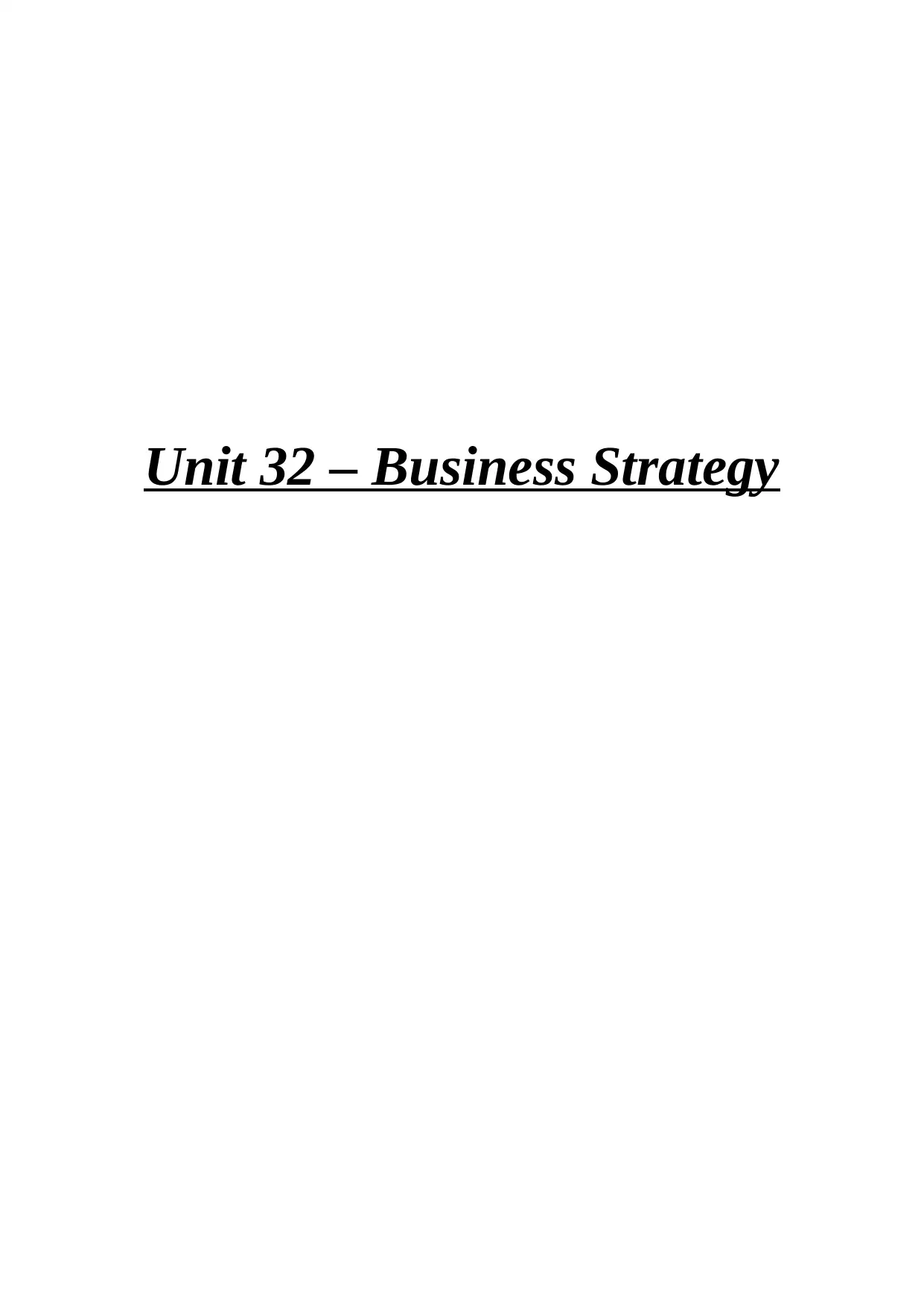
Unit 32 – Business Strategy
Paraphrase This Document
Need a fresh take? Get an instant paraphrase of this document with our AI Paraphraser

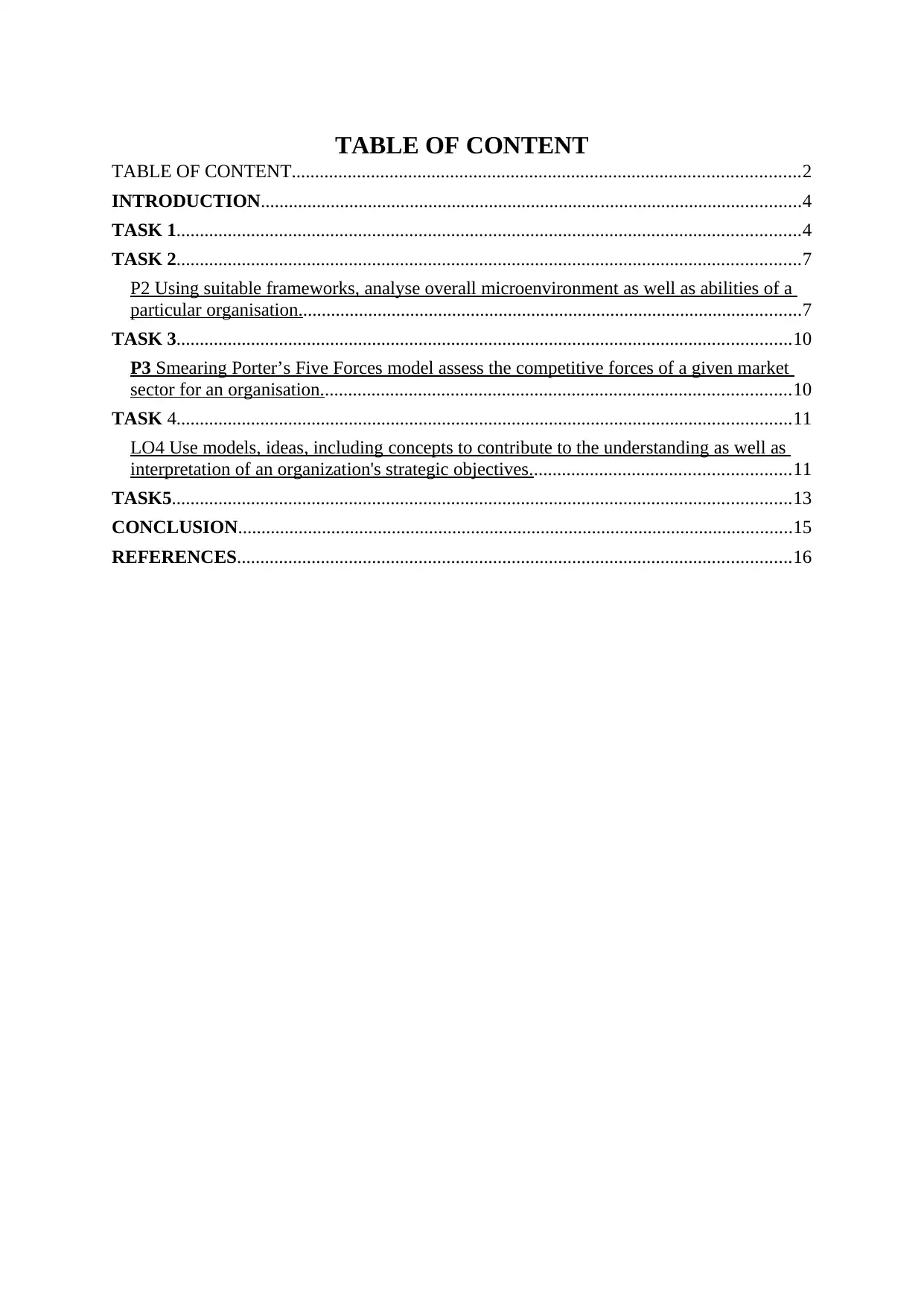
TABLE OF CONTENT
TABLE OF CONTENT.............................................................................................................2
INTRODUCTION....................................................................................................................4
TASK 1......................................................................................................................................4
TASK 2......................................................................................................................................7
P2 Using suitable frameworks, analyse overall microenvironment as well as abilities of a
particular organisation............................................................................................................7
TASK 3....................................................................................................................................10
P3 Smearing Porter’s Five Forces model assess the competitive forces of a given market
sector for an organisation.....................................................................................................10
TASK 4....................................................................................................................................11
LO4 Use models, ideas, including concepts to contribute to the understanding as well as
interpretation of an organization's strategic objectives........................................................11
TASK5.....................................................................................................................................13
CONCLUSION.......................................................................................................................15
REFERENCES.......................................................................................................................16
TABLE OF CONTENT.............................................................................................................2
INTRODUCTION....................................................................................................................4
TASK 1......................................................................................................................................4
TASK 2......................................................................................................................................7
P2 Using suitable frameworks, analyse overall microenvironment as well as abilities of a
particular organisation............................................................................................................7
TASK 3....................................................................................................................................10
P3 Smearing Porter’s Five Forces model assess the competitive forces of a given market
sector for an organisation.....................................................................................................10
TASK 4....................................................................................................................................11
LO4 Use models, ideas, including concepts to contribute to the understanding as well as
interpretation of an organization's strategic objectives........................................................11
TASK5.....................................................................................................................................13
CONCLUSION.......................................................................................................................15
REFERENCES.......................................................................................................................16
⊘ This is a preview!⊘
Do you want full access?
Subscribe today to unlock all pages.

Trusted by 1+ million students worldwide

Paraphrase This Document
Need a fresh take? Get an instant paraphrase of this document with our AI Paraphraser

INTRODUCTION
The efficacy of plan that a company employs determines its success. A strategy
defines how a firm expects to participate inside a market and grow profitably. Businesses all
over the globe sell products and services in competitive marketplaces, which necessitates
increasing the value for owners and shareholders in order to ensure their continued existence.
This necessitates the development of a strategy to assist managers in making good decisions
as well as efficiently allocating funds to accomplish important objectives (Amin and Masum,
2021).
This plan is often referred to as a business strategy. A business strategy provides a course of
action to fulfil an organization's vision as well as defined objectives, and it directs judgement
processes to enhance the corporate accounting sustainability in a competitive market. For this
report John Lewis & Partners Ltd. is considered which is a British corporation that owns and
manages John Lewis & Partners department shops, Waitrose & Partners supermarkets,
banking and finance, as well as other sales businesses.
In this report impact as well as influence of macro - environmental factors, examine
overall microenvironment as well as abilities and Porter’s Five Forces. Further this report
covers theories, concepts also models which will assist companies in strategic planning.
TASK 1
P1 Analyze the impact as well as influence of macro - environmental factors on a specific
organisation as well as its strategy using suitable frameworks.
John Lewis & Partners Ltd. John Lewis is indeed a public limited business that
operates numerous department shops solely in the United Kingdom. From 1929, the firm has
provided clients with low-cost alternatives to rival companies. Its company has expanded
from electronics appliances to fashionable attraction to toys. As a result, it is impossible to
conclude how this brand is solely aimed place at a single age group. It is the largest retailing
shop in the United Kingdom, with a focus to supplying consumers with high-quality items.
As in past, the firm did not have strong financial numbers, however when the senior
management has changed, an exceptional outcome was noticed. After the management
change, the profit continued to rise (Netz., Svensson and Brundin, 2020).
Analysis of the macroenvironment- The macro-environment is the external
environment wherein every organisation operates. This environment is vast as well as
The efficacy of plan that a company employs determines its success. A strategy
defines how a firm expects to participate inside a market and grow profitably. Businesses all
over the globe sell products and services in competitive marketplaces, which necessitates
increasing the value for owners and shareholders in order to ensure their continued existence.
This necessitates the development of a strategy to assist managers in making good decisions
as well as efficiently allocating funds to accomplish important objectives (Amin and Masum,
2021).
This plan is often referred to as a business strategy. A business strategy provides a course of
action to fulfil an organization's vision as well as defined objectives, and it directs judgement
processes to enhance the corporate accounting sustainability in a competitive market. For this
report John Lewis & Partners Ltd. is considered which is a British corporation that owns and
manages John Lewis & Partners department shops, Waitrose & Partners supermarkets,
banking and finance, as well as other sales businesses.
In this report impact as well as influence of macro - environmental factors, examine
overall microenvironment as well as abilities and Porter’s Five Forces. Further this report
covers theories, concepts also models which will assist companies in strategic planning.
TASK 1
P1 Analyze the impact as well as influence of macro - environmental factors on a specific
organisation as well as its strategy using suitable frameworks.
John Lewis & Partners Ltd. John Lewis is indeed a public limited business that
operates numerous department shops solely in the United Kingdom. From 1929, the firm has
provided clients with low-cost alternatives to rival companies. Its company has expanded
from electronics appliances to fashionable attraction to toys. As a result, it is impossible to
conclude how this brand is solely aimed place at a single age group. It is the largest retailing
shop in the United Kingdom, with a focus to supplying consumers with high-quality items.
As in past, the firm did not have strong financial numbers, however when the senior
management has changed, an exceptional outcome was noticed. After the management
change, the profit continued to rise (Netz., Svensson and Brundin, 2020).
Analysis of the macroenvironment- The macro-environment is the external
environment wherein every organisation operates. This environment is vast as well as
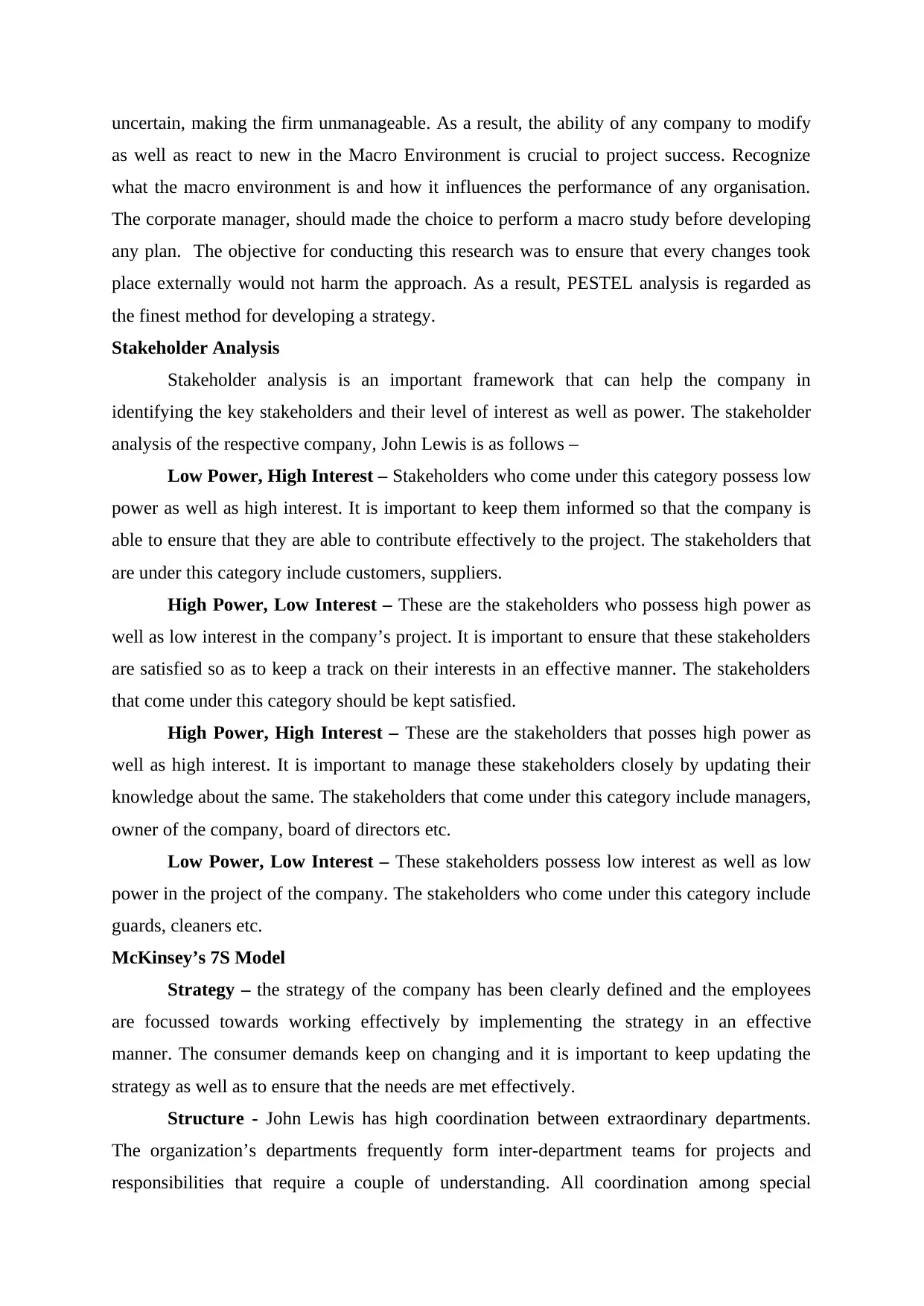
uncertain, making the firm unmanageable. As a result, the ability of any company to modify
as well as react to new in the Macro Environment is crucial to project success. Recognize
what the macro environment is and how it influences the performance of any organisation.
The corporate manager, should made the choice to perform a macro study before developing
any plan. The objective for conducting this research was to ensure that every changes took
place externally would not harm the approach. As a result, PESTEL analysis is regarded as
the finest method for developing a strategy.
Stakeholder Analysis
Stakeholder analysis is an important framework that can help the company in
identifying the key stakeholders and their level of interest as well as power. The stakeholder
analysis of the respective company, John Lewis is as follows –
Low Power, High Interest – Stakeholders who come under this category possess low
power as well as high interest. It is important to keep them informed so that the company is
able to ensure that they are able to contribute effectively to the project. The stakeholders that
are under this category include customers, suppliers.
High Power, Low Interest – These are the stakeholders who possess high power as
well as low interest in the company’s project. It is important to ensure that these stakeholders
are satisfied so as to keep a track on their interests in an effective manner. The stakeholders
that come under this category should be kept satisfied.
High Power, High Interest – These are the stakeholders that posses high power as
well as high interest. It is important to manage these stakeholders closely by updating their
knowledge about the same. The stakeholders that come under this category include managers,
owner of the company, board of directors etc.
Low Power, Low Interest – These stakeholders possess low interest as well as low
power in the project of the company. The stakeholders who come under this category include
guards, cleaners etc.
McKinsey’s 7S Model
Strategy – the strategy of the company has been clearly defined and the employees
are focussed towards working effectively by implementing the strategy in an effective
manner. The consumer demands keep on changing and it is important to keep updating the
strategy as well as to ensure that the needs are met effectively.
Structure - John Lewis has high coordination between extraordinary departments.
The organization’s departments frequently form inter-department teams for projects and
responsibilities that require a couple of understanding. All coordination among special
as well as react to new in the Macro Environment is crucial to project success. Recognize
what the macro environment is and how it influences the performance of any organisation.
The corporate manager, should made the choice to perform a macro study before developing
any plan. The objective for conducting this research was to ensure that every changes took
place externally would not harm the approach. As a result, PESTEL analysis is regarded as
the finest method for developing a strategy.
Stakeholder Analysis
Stakeholder analysis is an important framework that can help the company in
identifying the key stakeholders and their level of interest as well as power. The stakeholder
analysis of the respective company, John Lewis is as follows –
Low Power, High Interest – Stakeholders who come under this category possess low
power as well as high interest. It is important to keep them informed so that the company is
able to ensure that they are able to contribute effectively to the project. The stakeholders that
are under this category include customers, suppliers.
High Power, Low Interest – These are the stakeholders who possess high power as
well as low interest in the company’s project. It is important to ensure that these stakeholders
are satisfied so as to keep a track on their interests in an effective manner. The stakeholders
that come under this category should be kept satisfied.
High Power, High Interest – These are the stakeholders that posses high power as
well as high interest. It is important to manage these stakeholders closely by updating their
knowledge about the same. The stakeholders that come under this category include managers,
owner of the company, board of directors etc.
Low Power, Low Interest – These stakeholders possess low interest as well as low
power in the project of the company. The stakeholders who come under this category include
guards, cleaners etc.
McKinsey’s 7S Model
Strategy – the strategy of the company has been clearly defined and the employees
are focussed towards working effectively by implementing the strategy in an effective
manner. The consumer demands keep on changing and it is important to keep updating the
strategy as well as to ensure that the needs are met effectively.
Structure - John Lewis has high coordination between extraordinary departments.
The organization’s departments frequently form inter-department teams for projects and
responsibilities that require a couple of understanding. All coordination among special
⊘ This is a preview!⊘
Do you want full access?
Subscribe today to unlock all pages.

Trusted by 1+ million students worldwide

departments is powerful and prepared. The structure is well defined and the employees have a
clear idea of the same.
Systems - John Lewis Of Hungerford Plc has defined and properly-demarcated
structures in place to make sure that the enterprise operations are controlled correctly and that
there are no conflicts or disputes. Each of the defined and demarcated structures at John
Lewis has especially designed gear and techniques as controls for comparing overall
performance and purpose attainment. These controls and measures are designed especially in
one-of-a-kind departments primarily based on the character in their tasks and duties.
Moreover, every department also designs specific controls for participants for overall
performance evaluation, as well as for inter-departmental obligations and responsibilities.
Shared Values - The core values at John Lewis are defined and communicated to
foster a creative and supportive organizational shape in an effort to permit employees to carry
out optimally, and beautify their motivation and organizational commitment. John Lewis
encourages an inclusive way of life that celebrates variety. The organization has an
worldwide presence, and manufacturing units which can be unfold across specific countries,
as such, John Lewis make sure that its organizational tradition is supportive of variety, and
has internal regulations to lessen incidences of discrimination.
Style - John Lewis has a participative leadership style. Through a participative
leadership fashion, John Lewis Of Hungerford Plc is capable of interact and contain its
employees in selection-making tactics and managerial choices. This also permits the
leadership to often have interaction with the employees and exclusive managerial agencies to
perceive any capacity conflicts for decision, as well as for comments regarding strategic
techniques and operations.
Staff – John Lewis Of Hungerford Plc has a sufficient range of employees employed
throughout its global operations. Employees for extraordinary job roles and positions are
employed internally as well as externally – depending on the urgency and the talent stages
required.
Skills - John Lewis has a commendable workforce, with high abilities and capacities.
All employees are recruited based totally on their merit and qualifications. John Lewis Of
Hungerford Plc prides itself on hiring the first-rate professionals and grooming them further
to facilitate boom and improvement.
clear idea of the same.
Systems - John Lewis Of Hungerford Plc has defined and properly-demarcated
structures in place to make sure that the enterprise operations are controlled correctly and that
there are no conflicts or disputes. Each of the defined and demarcated structures at John
Lewis has especially designed gear and techniques as controls for comparing overall
performance and purpose attainment. These controls and measures are designed especially in
one-of-a-kind departments primarily based on the character in their tasks and duties.
Moreover, every department also designs specific controls for participants for overall
performance evaluation, as well as for inter-departmental obligations and responsibilities.
Shared Values - The core values at John Lewis are defined and communicated to
foster a creative and supportive organizational shape in an effort to permit employees to carry
out optimally, and beautify their motivation and organizational commitment. John Lewis
encourages an inclusive way of life that celebrates variety. The organization has an
worldwide presence, and manufacturing units which can be unfold across specific countries,
as such, John Lewis make sure that its organizational tradition is supportive of variety, and
has internal regulations to lessen incidences of discrimination.
Style - John Lewis has a participative leadership style. Through a participative
leadership fashion, John Lewis Of Hungerford Plc is capable of interact and contain its
employees in selection-making tactics and managerial choices. This also permits the
leadership to often have interaction with the employees and exclusive managerial agencies to
perceive any capacity conflicts for decision, as well as for comments regarding strategic
techniques and operations.
Staff – John Lewis Of Hungerford Plc has a sufficient range of employees employed
throughout its global operations. Employees for extraordinary job roles and positions are
employed internally as well as externally – depending on the urgency and the talent stages
required.
Skills - John Lewis has a commendable workforce, with high abilities and capacities.
All employees are recruited based totally on their merit and qualifications. John Lewis Of
Hungerford Plc prides itself on hiring the first-rate professionals and grooming them further
to facilitate boom and improvement.
Paraphrase This Document
Need a fresh take? Get an instant paraphrase of this document with our AI Paraphraser
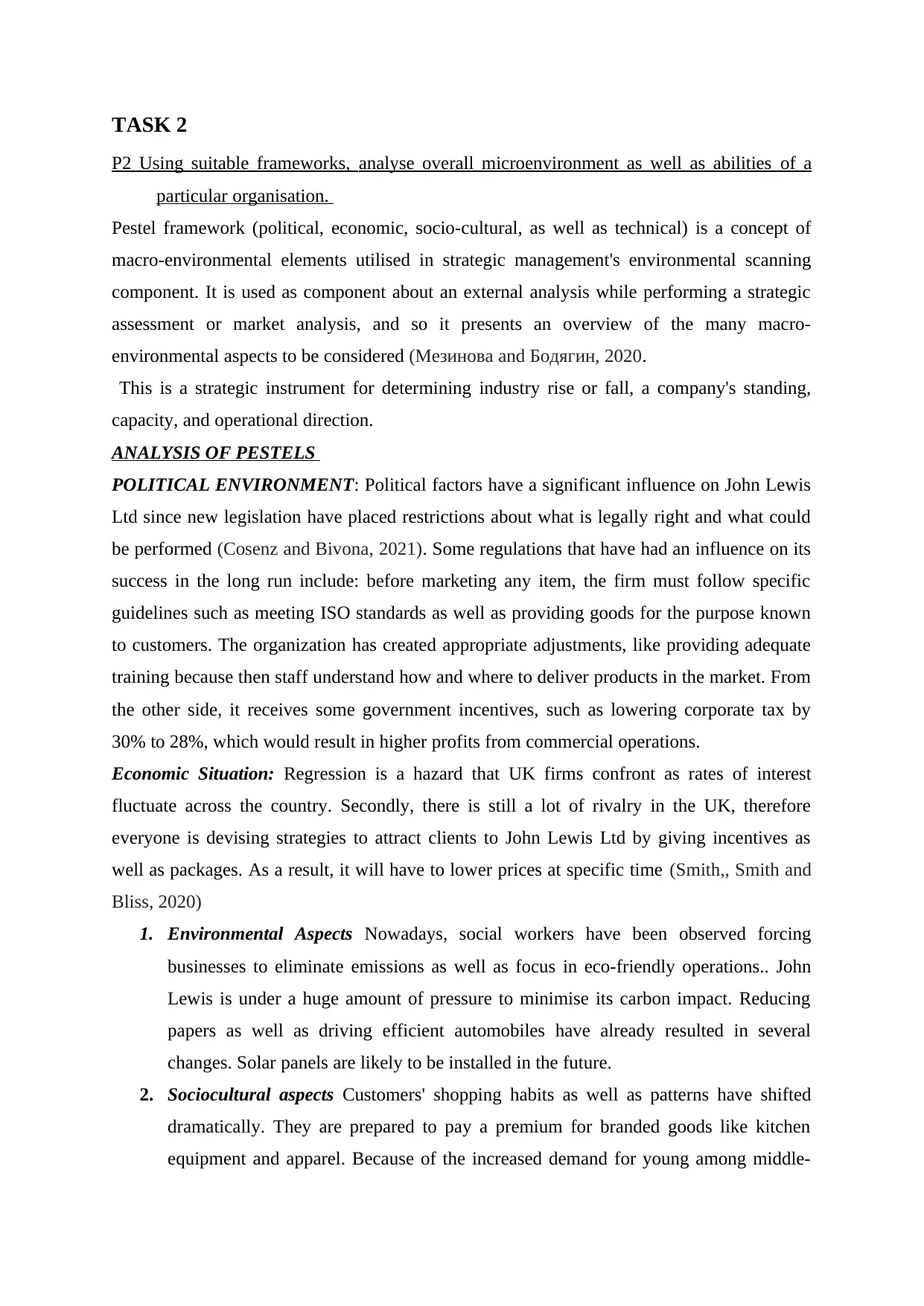
TASK 2
P2 Using suitable frameworks, analyse overall microenvironment as well as abilities of a
particular organisation.
Pestel framework (political, economic, socio-cultural, as well as technical) is a concept of
macro-environmental elements utilised in strategic management's environmental scanning
component. It is used as component about an external analysis while performing a strategic
assessment or market analysis, and so it presents an overview of the many macro-
environmental aspects to be considered (Мезинова and Бодягин, 2020.
This is a strategic instrument for determining industry rise or fall, a company's standing,
capacity, and operational direction.
ANALYSIS OF PESTELS
POLITICAL ENVIRONMENT: Political factors have a significant influence on John Lewis
Ltd since new legislation have placed restrictions about what is legally right and what could
be performed (Cosenz and Bivona, 2021). Some regulations that have had an influence on its
success in the long run include: before marketing any item, the firm must follow specific
guidelines such as meeting ISO standards as well as providing goods for the purpose known
to customers. The organization has created appropriate adjustments, like providing adequate
training because then staff understand how and where to deliver products in the market. From
the other side, it receives some government incentives, such as lowering corporate tax by
30% to 28%, which would result in higher profits from commercial operations.
Economic Situation: Regression is a hazard that UK firms confront as rates of interest
fluctuate across the country. Secondly, there is still a lot of rivalry in the UK, therefore
everyone is devising strategies to attract clients to John Lewis Ltd by giving incentives as
well as packages. As a result, it will have to lower prices at specific time (Smith,, Smith and
Bliss, 2020)
1. Environmental Aspects Nowadays, social workers have been observed forcing
businesses to eliminate emissions as well as focus in eco-friendly operations.. John
Lewis is under a huge amount of pressure to minimise its carbon impact. Reducing
papers as well as driving efficient automobiles have already resulted in several
changes. Solar panels are likely to be installed in the future.
2. Sociocultural aspects Customers' shopping habits as well as patterns have shifted
dramatically. They are prepared to pay a premium for branded goods like kitchen
equipment and apparel. Because of the increased demand for young among middle-
P2 Using suitable frameworks, analyse overall microenvironment as well as abilities of a
particular organisation.
Pestel framework (political, economic, socio-cultural, as well as technical) is a concept of
macro-environmental elements utilised in strategic management's environmental scanning
component. It is used as component about an external analysis while performing a strategic
assessment or market analysis, and so it presents an overview of the many macro-
environmental aspects to be considered (Мезинова and Бодягин, 2020.
This is a strategic instrument for determining industry rise or fall, a company's standing,
capacity, and operational direction.
ANALYSIS OF PESTELS
POLITICAL ENVIRONMENT: Political factors have a significant influence on John Lewis
Ltd since new legislation have placed restrictions about what is legally right and what could
be performed (Cosenz and Bivona, 2021). Some regulations that have had an influence on its
success in the long run include: before marketing any item, the firm must follow specific
guidelines such as meeting ISO standards as well as providing goods for the purpose known
to customers. The organization has created appropriate adjustments, like providing adequate
training because then staff understand how and where to deliver products in the market. From
the other side, it receives some government incentives, such as lowering corporate tax by
30% to 28%, which would result in higher profits from commercial operations.
Economic Situation: Regression is a hazard that UK firms confront as rates of interest
fluctuate across the country. Secondly, there is still a lot of rivalry in the UK, therefore
everyone is devising strategies to attract clients to John Lewis Ltd by giving incentives as
well as packages. As a result, it will have to lower prices at specific time (Smith,, Smith and
Bliss, 2020)
1. Environmental Aspects Nowadays, social workers have been observed forcing
businesses to eliminate emissions as well as focus in eco-friendly operations.. John
Lewis is under a huge amount of pressure to minimise its carbon impact. Reducing
papers as well as driving efficient automobiles have already resulted in several
changes. Solar panels are likely to be installed in the future.
2. Sociocultural aspects Customers' shopping habits as well as patterns have shifted
dramatically. They are prepared to pay a premium for branded goods like kitchen
equipment and apparel. Because of the increased demand for young among middle-

aged individuals, John Lewis Ltd has precisely assessed this development as well as,
as a result, has hired additional workers in the clothes category.
Technical There is indeed a constant change in demand due to the advancement of internet
in client purchasing patterns. John Lewis has launched a website shopping platform where
customers may purchase by simply registering on the website. They may also provide
comments and file complaints using that platform. The proper IT team has been created in
order to handle any difficulties that may arise during a crisis. John Lewis additionally
benefited suppliers by allowing them to place orders online rather than via phone or text
message. As a result, there is reduced risk of error while submitting orders. It is a feature in
John Lewis' favour. Sixth. Legal John Lewis works for a firm that requires employees over
the age of 25 to be paid at least $7.20 per hour. It is required to pay salaries on time,
regardless of the state of the company (Fabeil, Pazim and Langgat, 2020)
SWOT analysis
SWOT is a long term planning approach being used assist an individual or
organization in identifying strengths, flaws, possibilities, as well as threats in
commercial rivalry or project preparation.
SWOT ANALYSIS
1. Capabilities
I. It does have a good brand image as well as a high rate of customer retention.
II. Profits increased dramatically following 2001 and to have continued to rise slowly.
III. A well-trained and talented staff that adds to the company's success.
IV. A significant internet footprint across social media sites
2. Shortcoming
I. Rapid cost decreases owing to intense competition, that causes buyers to question
the quality of items
II. Several financiers criticise the firm for something like a lack of clarity
3. Dangers
I. Direct as well as indirect rivals are likely to enter the UK
4. Possibilities
I. International prospects and unexplored markets
II. Internet persona will also have a positive influence on performance because more
prospective consumers would be attracted.
Balance Scorecard
A balanced scorecard is a strategic management performance metric that enables
as a result, has hired additional workers in the clothes category.
Technical There is indeed a constant change in demand due to the advancement of internet
in client purchasing patterns. John Lewis has launched a website shopping platform where
customers may purchase by simply registering on the website. They may also provide
comments and file complaints using that platform. The proper IT team has been created in
order to handle any difficulties that may arise during a crisis. John Lewis additionally
benefited suppliers by allowing them to place orders online rather than via phone or text
message. As a result, there is reduced risk of error while submitting orders. It is a feature in
John Lewis' favour. Sixth. Legal John Lewis works for a firm that requires employees over
the age of 25 to be paid at least $7.20 per hour. It is required to pay salaries on time,
regardless of the state of the company (Fabeil, Pazim and Langgat, 2020)
SWOT analysis
SWOT is a long term planning approach being used assist an individual or
organization in identifying strengths, flaws, possibilities, as well as threats in
commercial rivalry or project preparation.
SWOT ANALYSIS
1. Capabilities
I. It does have a good brand image as well as a high rate of customer retention.
II. Profits increased dramatically following 2001 and to have continued to rise slowly.
III. A well-trained and talented staff that adds to the company's success.
IV. A significant internet footprint across social media sites
2. Shortcoming
I. Rapid cost decreases owing to intense competition, that causes buyers to question
the quality of items
II. Several financiers criticise the firm for something like a lack of clarity
3. Dangers
I. Direct as well as indirect rivals are likely to enter the UK
4. Possibilities
I. International prospects and unexplored markets
II. Internet persona will also have a positive influence on performance because more
prospective consumers would be attracted.
Balance Scorecard
A balanced scorecard is a strategic management performance metric that enables
⊘ This is a preview!⊘
Do you want full access?
Subscribe today to unlock all pages.

Trusted by 1+ million students worldwide
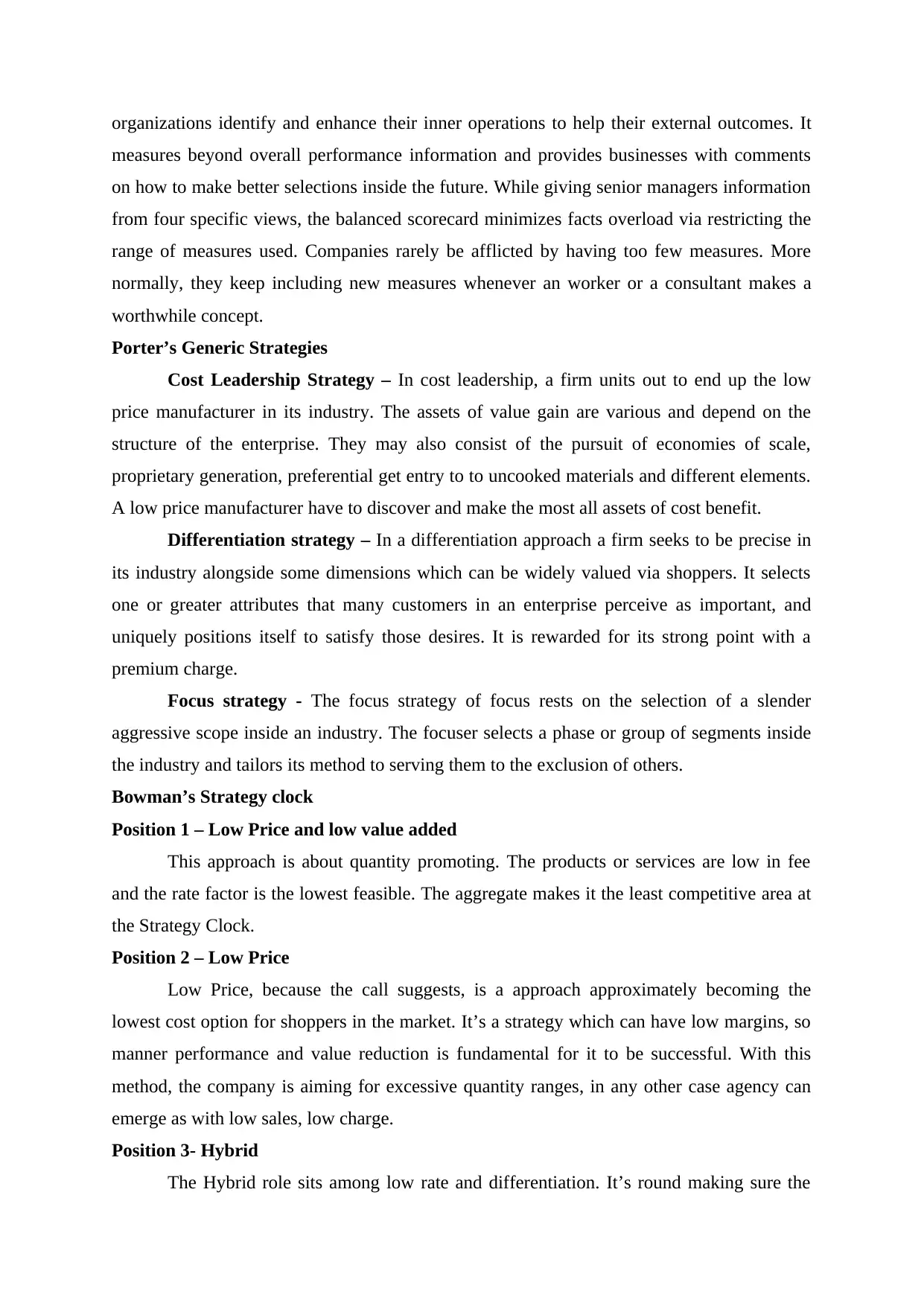
organizations identify and enhance their inner operations to help their external outcomes. It
measures beyond overall performance information and provides businesses with comments
on how to make better selections inside the future. While giving senior managers information
from four specific views, the balanced scorecard minimizes facts overload via restricting the
range of measures used. Companies rarely be afflicted by having too few measures. More
normally, they keep including new measures whenever an worker or a consultant makes a
worthwhile concept.
Porter’s Generic Strategies
Cost Leadership Strategy – In cost leadership, a firm units out to end up the low
price manufacturer in its industry. The assets of value gain are various and depend on the
structure of the enterprise. They may also consist of the pursuit of economies of scale,
proprietary generation, preferential get entry to to uncooked materials and different elements.
A low price manufacturer have to discover and make the most all assets of cost benefit.
Differentiation strategy – In a differentiation approach a firm seeks to be precise in
its industry alongside some dimensions which can be widely valued via shoppers. It selects
one or greater attributes that many customers in an enterprise perceive as important, and
uniquely positions itself to satisfy those desires. It is rewarded for its strong point with a
premium charge.
Focus strategy - The focus strategy of focus rests on the selection of a slender
aggressive scope inside an industry. The focuser selects a phase or group of segments inside
the industry and tailors its method to serving them to the exclusion of others.
Bowman’s Strategy clock
Position 1 – Low Price and low value added
This approach is about quantity promoting. The products or services are low in fee
and the rate factor is the lowest feasible. The aggregate makes it the least competitive area at
the Strategy Clock.
Position 2 – Low Price
Low Price, because the call suggests, is a approach approximately becoming the
lowest cost option for shoppers in the market. It’s a strategy which can have low margins, so
manner performance and value reduction is fundamental for it to be successful. With this
method, the company is aiming for excessive quantity ranges, in any other case agency can
emerge as with low sales, low charge.
Position 3- Hybrid
The Hybrid role sits among low rate and differentiation. It’s round making sure the
measures beyond overall performance information and provides businesses with comments
on how to make better selections inside the future. While giving senior managers information
from four specific views, the balanced scorecard minimizes facts overload via restricting the
range of measures used. Companies rarely be afflicted by having too few measures. More
normally, they keep including new measures whenever an worker or a consultant makes a
worthwhile concept.
Porter’s Generic Strategies
Cost Leadership Strategy – In cost leadership, a firm units out to end up the low
price manufacturer in its industry. The assets of value gain are various and depend on the
structure of the enterprise. They may also consist of the pursuit of economies of scale,
proprietary generation, preferential get entry to to uncooked materials and different elements.
A low price manufacturer have to discover and make the most all assets of cost benefit.
Differentiation strategy – In a differentiation approach a firm seeks to be precise in
its industry alongside some dimensions which can be widely valued via shoppers. It selects
one or greater attributes that many customers in an enterprise perceive as important, and
uniquely positions itself to satisfy those desires. It is rewarded for its strong point with a
premium charge.
Focus strategy - The focus strategy of focus rests on the selection of a slender
aggressive scope inside an industry. The focuser selects a phase or group of segments inside
the industry and tailors its method to serving them to the exclusion of others.
Bowman’s Strategy clock
Position 1 – Low Price and low value added
This approach is about quantity promoting. The products or services are low in fee
and the rate factor is the lowest feasible. The aggregate makes it the least competitive area at
the Strategy Clock.
Position 2 – Low Price
Low Price, because the call suggests, is a approach approximately becoming the
lowest cost option for shoppers in the market. It’s a strategy which can have low margins, so
manner performance and value reduction is fundamental for it to be successful. With this
method, the company is aiming for excessive quantity ranges, in any other case agency can
emerge as with low sales, low charge.
Position 3- Hybrid
The Hybrid role sits among low rate and differentiation. It’s round making sure the
Paraphrase This Document
Need a fresh take? Get an instant paraphrase of this document with our AI Paraphraser

fee is aggressive, ideally with a low perceived rate from buyers, even as promoting the added
cost aspects of the product.
Position 4 – Differentiation
The Differentiation strategy is where a enterprise focuses on differentiating their
services or products from competitors by way of including high perceived fee. This method
has a huge spectrum from full product diversity via to precise features within a middle
product.
Position 5 – Focussed Differentiation
Focused Differentiation is ready supplying excessive price at a excessive charge (not
to be stressed with Porter’s Generic Strategy of the same call, which talks about going to a
spot market).
Position 6 – Risky High Margins
Usually, that is a brief-term strategy to make the most brief marketplace deliver
disequilibrium. The customer price proposition does not warrant the higher price. Some
customers will retain to buy until they identify a appropriate substitute or a substitute. Over
time, fewer customers will purchase the product. In a market wherein substitutes aren't
effectively available, this strategy can grasp a better margin for a transient length.
Position 7 – Monopoly Pricing
A business enterprise that enjoys a monopoly function is much less concerned about
perceived customer cost or pricing. The patron is reliant on the company for the goods it
gives.
Position 8 – Loss of Market Share
This is typically the worst position to be in and indicates that the business enterprise is
exiting the market or is in decline. It can be that they've selected this method as a part of a
move to more modern markets, or it is able to be forced upon them due to getting their fee or
market suit incorrect.
TASK 3
P3 Smearing Porter’s Five Forces model assess the competitive forces of a given market
sector for an organisation.
Porter's Five Forces Framework is a framework for analysing a company's competitiveness. It
derives five forces in industrial organisation economy that affect the competitive strength
and, hence, the industry attractiveness in terms of profitability (Lawler, 2020).
cost aspects of the product.
Position 4 – Differentiation
The Differentiation strategy is where a enterprise focuses on differentiating their
services or products from competitors by way of including high perceived fee. This method
has a huge spectrum from full product diversity via to precise features within a middle
product.
Position 5 – Focussed Differentiation
Focused Differentiation is ready supplying excessive price at a excessive charge (not
to be stressed with Porter’s Generic Strategy of the same call, which talks about going to a
spot market).
Position 6 – Risky High Margins
Usually, that is a brief-term strategy to make the most brief marketplace deliver
disequilibrium. The customer price proposition does not warrant the higher price. Some
customers will retain to buy until they identify a appropriate substitute or a substitute. Over
time, fewer customers will purchase the product. In a market wherein substitutes aren't
effectively available, this strategy can grasp a better margin for a transient length.
Position 7 – Monopoly Pricing
A business enterprise that enjoys a monopoly function is much less concerned about
perceived customer cost or pricing. The patron is reliant on the company for the goods it
gives.
Position 8 – Loss of Market Share
This is typically the worst position to be in and indicates that the business enterprise is
exiting the market or is in decline. It can be that they've selected this method as a part of a
move to more modern markets, or it is able to be forced upon them due to getting their fee or
market suit incorrect.
TASK 3
P3 Smearing Porter’s Five Forces model assess the competitive forces of a given market
sector for an organisation.
Porter's Five Forces Framework is a framework for analysing a company's competitiveness. It
derives five forces in industrial organisation economy that affect the competitive strength
and, hence, the industry attractiveness in terms of profitability (Lawler, 2020).
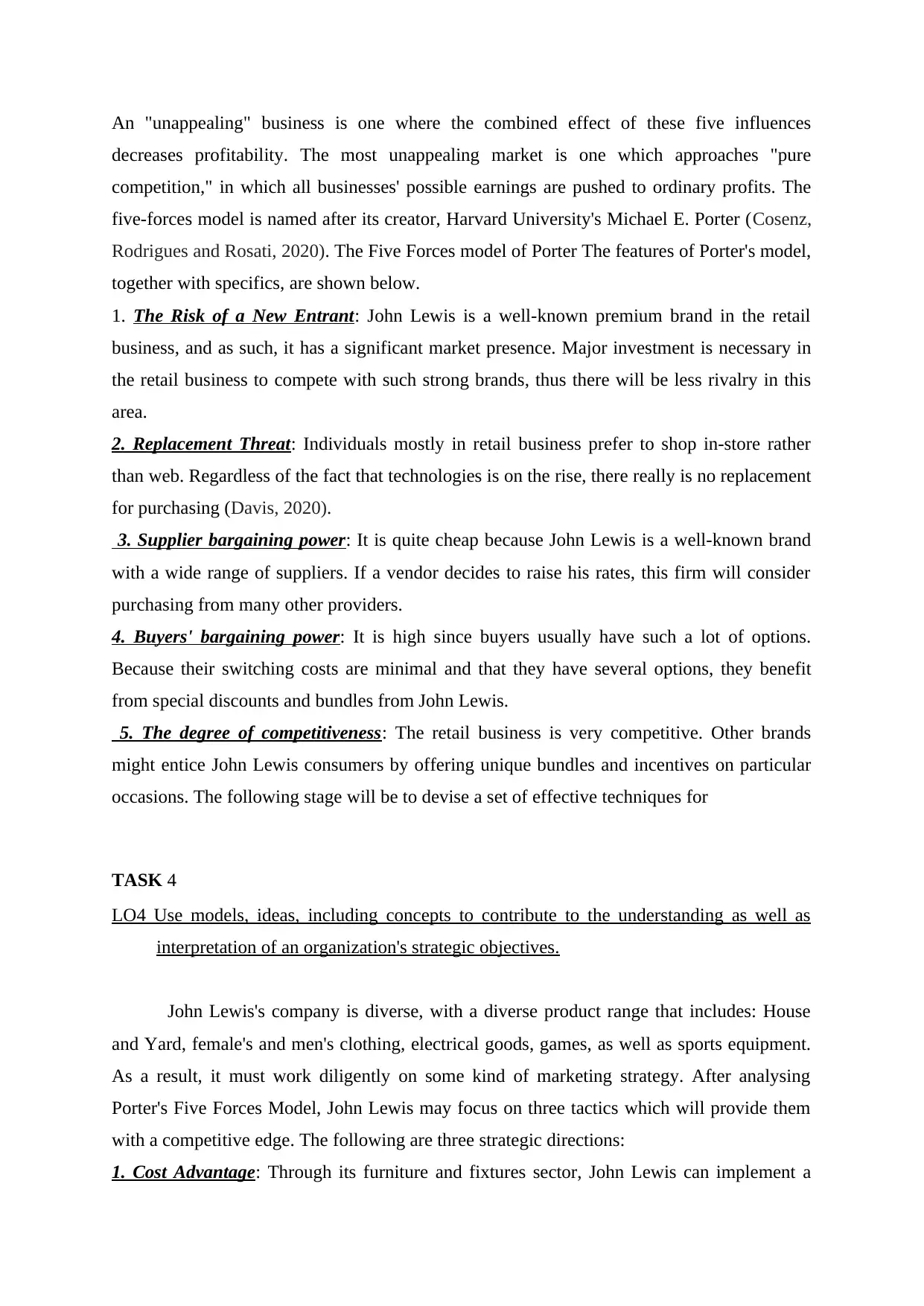
An "unappealing" business is one where the combined effect of these five influences
decreases profitability. The most unappealing market is one which approaches "pure
competition," in which all businesses' possible earnings are pushed to ordinary profits. The
five-forces model is named after its creator, Harvard University's Michael E. Porter (Cosenz,
Rodrigues and Rosati, 2020). The Five Forces model of Porter The features of Porter's model,
together with specifics, are shown below.
1. The Risk of a New Entrant: John Lewis is a well-known premium brand in the retail
business, and as such, it has a significant market presence. Major investment is necessary in
the retail business to compete with such strong brands, thus there will be less rivalry in this
area.
2. Replacement Threat: Individuals mostly in retail business prefer to shop in-store rather
than web. Regardless of the fact that technologies is on the rise, there really is no replacement
for purchasing (Davis, 2020).
3. Supplier bargaining power: It is quite cheap because John Lewis is a well-known brand
with a wide range of suppliers. If a vendor decides to raise his rates, this firm will consider
purchasing from many other providers.
4. Buyers' bargaining power: It is high since buyers usually have such a lot of options.
Because their switching costs are minimal and that they have several options, they benefit
from special discounts and bundles from John Lewis.
5. The degree of competitiveness: The retail business is very competitive. Other brands
might entice John Lewis consumers by offering unique bundles and incentives on particular
occasions. The following stage will be to devise a set of effective techniques for
TASK 4
LO4 Use models, ideas, including concepts to contribute to the understanding as well as
interpretation of an organization's strategic objectives.
John Lewis's company is diverse, with a diverse product range that includes: House
and Yard, female's and men's clothing, electrical goods, games, as well as sports equipment.
As a result, it must work diligently on some kind of marketing strategy. After analysing
Porter's Five Forces Model, John Lewis may focus on three tactics which will provide them
with a competitive edge. The following are three strategic directions:
1. Cost Advantage: Through its furniture and fixtures sector, John Lewis can implement a
decreases profitability. The most unappealing market is one which approaches "pure
competition," in which all businesses' possible earnings are pushed to ordinary profits. The
five-forces model is named after its creator, Harvard University's Michael E. Porter (Cosenz,
Rodrigues and Rosati, 2020). The Five Forces model of Porter The features of Porter's model,
together with specifics, are shown below.
1. The Risk of a New Entrant: John Lewis is a well-known premium brand in the retail
business, and as such, it has a significant market presence. Major investment is necessary in
the retail business to compete with such strong brands, thus there will be less rivalry in this
area.
2. Replacement Threat: Individuals mostly in retail business prefer to shop in-store rather
than web. Regardless of the fact that technologies is on the rise, there really is no replacement
for purchasing (Davis, 2020).
3. Supplier bargaining power: It is quite cheap because John Lewis is a well-known brand
with a wide range of suppliers. If a vendor decides to raise his rates, this firm will consider
purchasing from many other providers.
4. Buyers' bargaining power: It is high since buyers usually have such a lot of options.
Because their switching costs are minimal and that they have several options, they benefit
from special discounts and bundles from John Lewis.
5. The degree of competitiveness: The retail business is very competitive. Other brands
might entice John Lewis consumers by offering unique bundles and incentives on particular
occasions. The following stage will be to devise a set of effective techniques for
TASK 4
LO4 Use models, ideas, including concepts to contribute to the understanding as well as
interpretation of an organization's strategic objectives.
John Lewis's company is diverse, with a diverse product range that includes: House
and Yard, female's and men's clothing, electrical goods, games, as well as sports equipment.
As a result, it must work diligently on some kind of marketing strategy. After analysing
Porter's Five Forces Model, John Lewis may focus on three tactics which will provide them
with a competitive edge. The following are three strategic directions:
1. Cost Advantage: Through its furniture and fixtures sector, John Lewis can implement a
⊘ This is a preview!⊘
Do you want full access?
Subscribe today to unlock all pages.

Trusted by 1+ million students worldwide
1 out of 18
Related Documents
Your All-in-One AI-Powered Toolkit for Academic Success.
+13062052269
info@desklib.com
Available 24*7 on WhatsApp / Email
![[object Object]](/_next/static/media/star-bottom.7253800d.svg)
Unlock your academic potential
Copyright © 2020–2025 A2Z Services. All Rights Reserved. Developed and managed by ZUCOL.





